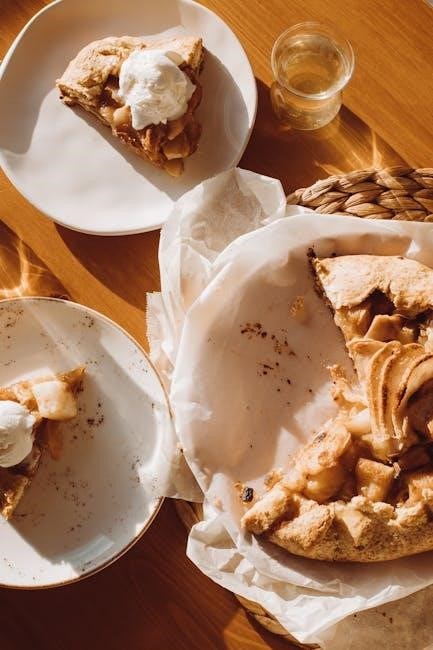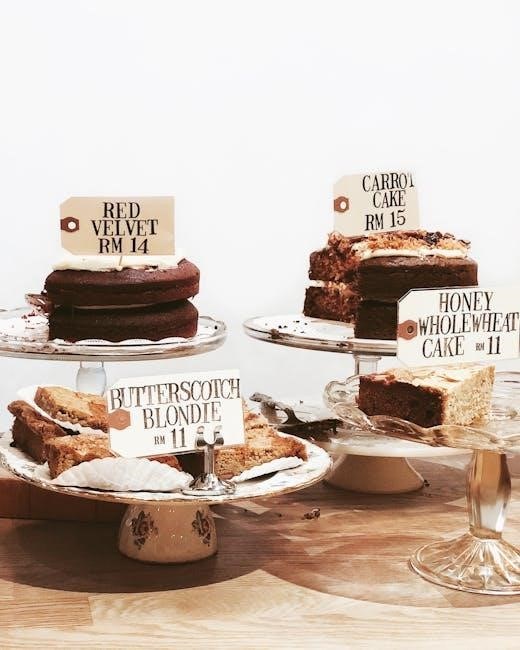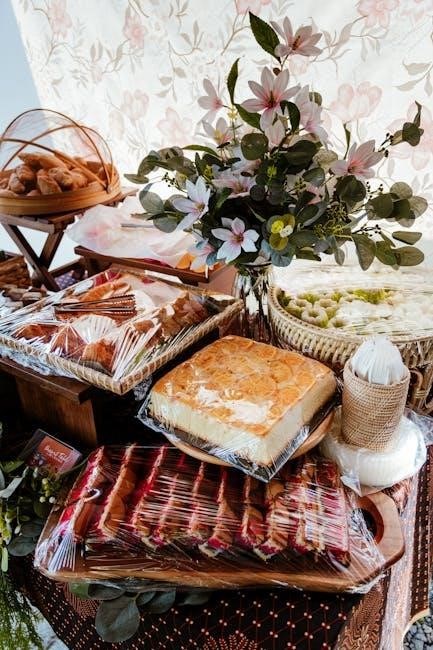Pricing is crucial for profitability and customer satisfaction. This guide covers understanding costs, market trends, and strategies, offering practical tips for fair and competitive pricing in 2023.
1.1 Why Pricing is Important for Bakers
Pricing is essential for bakers as it directly impacts profitability and sustainability. Accurate pricing ensures that all costs—ingredients, labor, and overhead—are covered while generating a profit. It also reflects the value of your craft, attracting customers willing to pay for quality. Proper pricing helps build a strong brand reputation and customer loyalty. Additionally, it allows bakers to compete effectively in the market and adapt to changing demand. Fair pricing also ensures transparency, fostering trust with customers. Without proper pricing, bakers risk undervaluing their work or overcharging, leading to financial instability. Mastering pricing is a critical skill for long-term success in the baking industry, ensuring both profitability and customer satisfaction.
1.2 Overview of the Cake Pricing Guide 2023
The Cake Pricing Guide 2023 provides a comprehensive approach to determining fair and profitable prices for baked goods. It covers key areas such as understanding ingredient costs, calculating labor expenses, and analyzing market trends. The guide also explores various pricing strategies, including cost-plus and value-based methods, to suit different business needs. With practical tips and real-world examples, it helps bakers set prices that reflect the value of their work while staying competitive. Additionally, the guide emphasizes the importance of considering overheads, profit margins, and customer demand; Whether you’re a home baker or a commercial bakery, this guide offers insights to help you price your cakes effectively and sustainably in 2023.

Understanding Costs
Understanding costs involves calculating ingredient expenses, labor, and overhead to ensure accurate pricing and profitability for your baked goods, ensuring sustainability and fair pricing.
2.1 Cost of Ingredients
The cost of ingredients is a critical component in cake pricing. Start by listing all ingredients used in your recipes, noting their quantities and prices. Use receipts and packaging to calculate exact costs. For example, if a recipe requires 2 cups of flour priced at $2 per bag, determine how many cups are in a bag and the cost per cup. This granular approach ensures accuracy. Additionally, consider fluctuating ingredient prices due to market changes or seasons. Regularly updating your ingredient costs helps maintain profitability. Tracking these expenses is essential for setting competitive yet sustainable prices for your cakes.
2.2 Labor Costs
Labor costs are a significant factor in cake pricing. Calculate the time spent on each cake, including preparation, baking, and decorating. Determine your hourly rate, reflecting your skill level and business goals. For example, if a cake takes 3 hours to make and your rate is $20/hour, add $60 to the price. Labor costs vary depending on cake complexity and your expertise. Track time for each order to understand labor expenses accurately. This ensures fair pricing and profitability. Remember, labor costs are as important as ingredient costs and should never be overlooked. Use tools like spreadsheets or apps to streamline labor cost calculations and maintain consistency in pricing.

Pricing Strategies
Effective pricing strategies balance profitability and customer affordability. Common methods include cost-plus, value-based, and competitive pricing. Choose a strategy that aligns with your business goals and target market.
3.1 Cost-Plus Pricing
Cost-plus pricing is a straightforward method where you calculate total costs, including ingredients, labor, and overheads, then add a desired profit margin. This ensures profitability and sustainability. For example, if a cake costs $30 to make and you aim for a 50% margin, the selling price would be $45. This strategy is simple to implement and provides clear profitability. However, it may not account for market demand or competition. Regularly reviewing costs and adjusting margins helps maintain competitiveness while ensuring fair pricing for both the business and customers.
3.2 Value-Based Pricing
Value-based pricing sets prices according to the perceived value of your cakes to customers. This method focuses on what buyers are willing to pay, considering factors like quality, uniqueness, and presentation. For example, a custom cake with intricate designs or premium ingredients may command a higher price due to its exclusivity. This strategy requires understanding your target market and competition to align prices with customer expectations. It’s ideal for bakers offering specialized or high-end products, as it reflects the added value beyond basic costs. Regularly researching customer preferences ensures this approach remains effective and profitable. This method emphasizes brand reputation and customer satisfaction.

Market Research
Researching competitors and understanding customer demand helps set realistic prices. Analyze market trends, consumer preferences, and rival pricing to ensure your cakes are competitively and fairly priced.
4.1 Researching Competitors
Researching competitors is essential to understand the market dynamics. Start by visiting competitors’ websites or social media to analyze their pricing strategies and menu offerings. Note the prices of similar cake products, including custom and standard designs. Identify what makes your cakes unique compared to theirs, such as quality, ingredients, or presentation. Consider factors like location, brand reputation, and target audience when comparing prices. This analysis helps you position your pricing competitively while reflecting your cakes’ value. Additionally, observe customer reviews to gauge satisfaction and identify gaps in their offerings that you can exploit. Recording competitor data regularly ensures you stay updated on market trends. This step is vital for setting prices that attract customers and maintain profitability.
4.2 Understanding Customer Demand
Understanding customer demand is critical for effective pricing. Start by identifying your target audience and their preferences, such as custom cakes, seasonal trends, or dietary restrictions. Analyze what customers are willing to pay for based on factors like location, ingredient quality, and design complexity. Monitor customer feedback and reviews to gauge satisfaction and identify popular products. Consider the occasions customers purchase cakes for, such as weddings or birthdays, as these may command higher prices. Stay informed about market trends, like the rise in demand for vegan or gluten-free options. By aligning your pricing with customer demand and preferences, you can create a menu that attracts buyers and reflects the value they perceive in your cakes. Regularly updating your offerings based on customer insights ensures long-term success.
Calculating the Final Price
Add recipe costs, labor, and overhead, then apply your desired profit margin to determine the final price, ensuring accuracy and profitability for your baked goods.
5.1 Calculating Recipe Costs
To calculate recipe costs, list all ingredients, their quantities, and prices. Use receipts to determine costs, then create a spreadsheet for precise calculations. Track each ingredient’s cost per unit, adjust for recipe size, and account for waste. Regularly update prices as they fluctuate. This systematic approach ensures accurate cost determination, helping set fair and profitable cake prices. Tools or apps can automate calculations, saving time and reducing errors. Stay current with price changes to reflect accurate expenses and maintain profitability. This method provides a clear, organized way to manage recipe costs effectively.
5.2 Determining Profit Margins
Determining profit margins involves calculating desired profit and setting selling prices accordingly. After calculating base costs (ingredients, labor, overhead), add a profit percentage. Use spreadsheets for accurate calculations. Regularly update prices as costs change. Consider offering extras like fondant toppings to increase margins. Tools help streamline this process, ensuring competitiveness and profitability.

Advanced Tips for Pricing
Advanced pricing tips include strategies for custom cakes, handling negotiations, and using tools to streamline calculations, ensuring efficiency and profitability in your pricing approach.
6.1 Pricing for Custom Cakes
Pricing custom cakes requires careful consideration of design complexity, ingredient quality, and time. Start by calculating labor costs, factoring in hours spent on design and execution. Add the cost of premium ingredients and overhead expenses. For intricate designs or specialty elements, include an additional fee. Consider the client’s budget while ensuring a fair profit margin. Use spreadsheets or pricing tools to streamline calculations. Research competitors to align your prices with market standards. Clearly communicate the breakdown to clients, emphasizing the value of custom work. This approach ensures transparency and customer satisfaction while maintaining profitability for your business.
6.2 Handling Price Negotiations
Handling price negotiations requires a balance of professionalism and flexibility. Set clear boundaries while understanding the client’s budget constraints. Be transparent about the breakdown of costs, ensuring the client sees the value in your work. Offer alternatives, like simpler designs, if they hesitate over price. Know when to compromise, but never undervalue your time and expertise. Use negotiation as an opportunity to build trust and showcase your professionalism. Always aim for a fair agreement that satisfies both parties, maintaining your profit margins while ensuring customer satisfaction.
